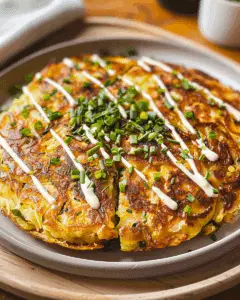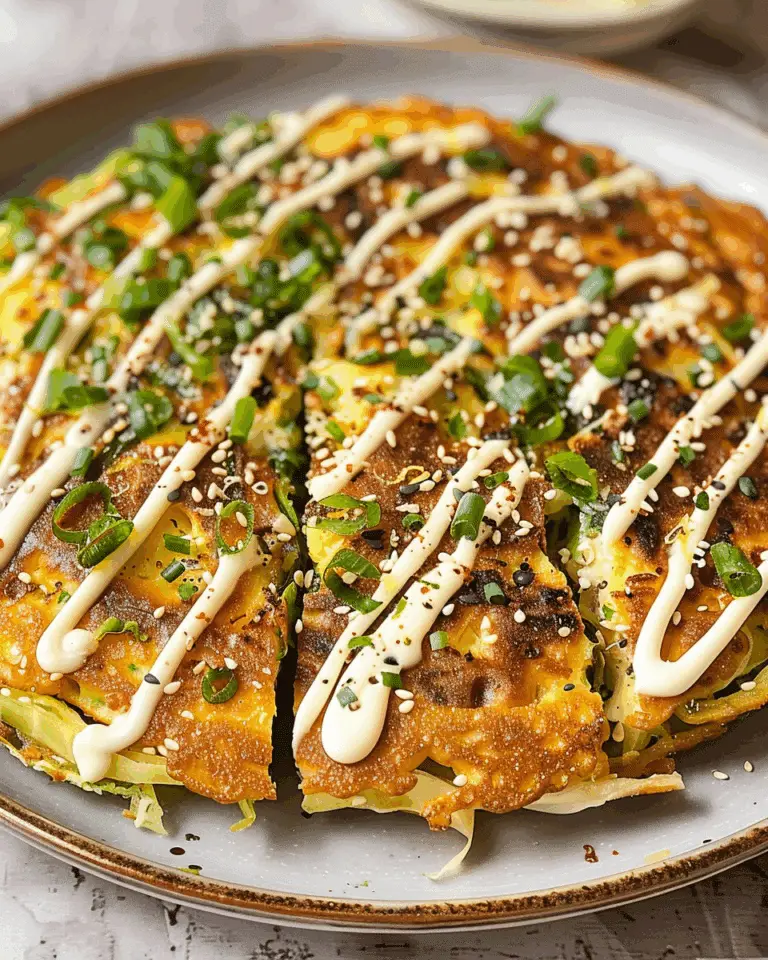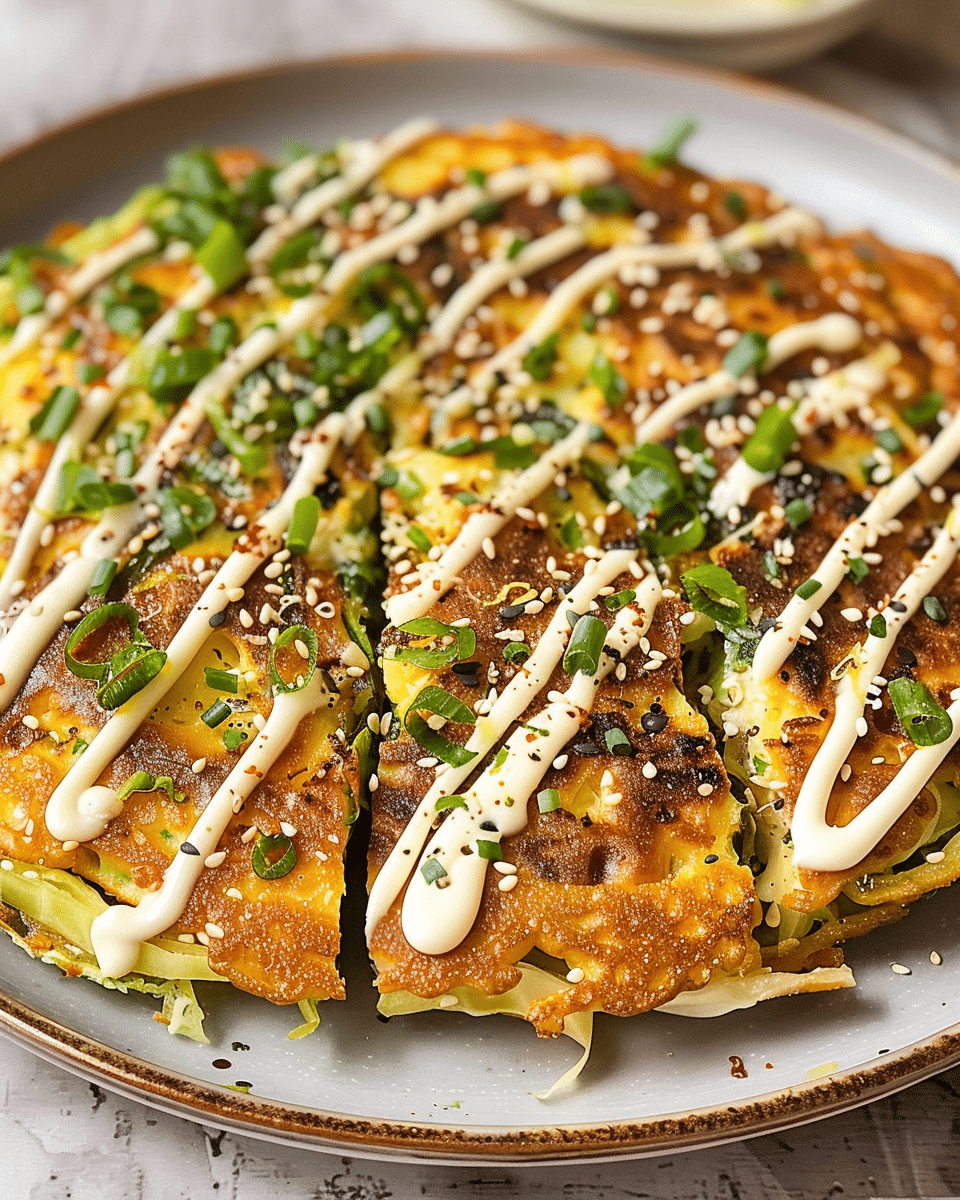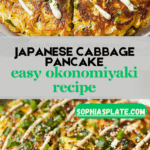Okonomiyaki is a savory Japanese pancake made primarily with cabbage and a simple batter. The name literally means “grilled as you like it,” reflecting how customizable this comfort food can be. This street food staple is crispy on the outside, tender on the inside, and topped with delicious sauces that create a perfect umami flavor experience.
Why You’ll Love This Recipe
- Quick and easy to prepare – ready in just 20 minutes
- Customizable with various add-ins and toppings
- Perfect balance of textures – crispy exterior with a soft, vegetable-filled interior
- Introduces authentic Japanese flavors in an approachable way
- Makes for a satisfying light meal or impressive appetizer
- Budget-friendly using simple, accessible ingredients
- Great way to use up leftover vegetables
Ingredients
(Tip: You’ll find the full list of ingredients and measurements in the recipe card below.)
Cabbage forms the backbone of okonomiyaki, providing texture, volume, and a mild sweetness when cooked. It should be shredded finely for the best texture and quick cooking.
All-purpose flour acts as the binding agent, creating structure in the pancake while allowing the cabbage to remain the star. For a gluten-free version, a 1:1 gluten-free flour blend can work well.
Eggs help bind all the ingredients together while adding richness and protein to the pancake. They’re essential for achieving the right texture.
Dashi or vegetable broth provides moisture and umami depth. Traditional okonomiyaki uses dashi (Japanese fish and seaweed stock), but vegetable broth makes a fine substitute for a vegetarian version.
Soy sauce introduces saltiness and that characteristic umami flavor that’s essential to Japanese cuisine. Use low-sodium if you’re watching salt intake.
Sesame oil contributes a nutty aroma and distinctive flavor that elevates the pancake. Just a small amount goes a long way.
Green onions add a fresh, mild onion flavor and a pop of color. Both the white and green parts can be used for different texture and flavor notes.
Okonomiyaki sauce is a thick, sweet-savory condiment similar to Worcestershire sauce but sweeter and thicker. It’s the classic topping that gives okonomiyaki its distinctive flavor.
Mayonnaise, specifically Japanese mayonnaise if available, adds richness and creaminess that balances the savory elements. It’s traditionally drizzled in a zigzag pattern over the finished pancake.
Oil for frying should be a neutral oil with a high smoke point, like canola or vegetable oil, to achieve that perfect golden crust without imparting additional flavors.
Directions
- In a large bowl, mix the shredded cabbage, flour, egg, dashi, soy sauce, sesame oil, and green onions to form a batter.
- Heat oil in a skillet over medium heat. Pour half of the batter into the skillet and shape into a round pancake.
- Cook for 3-4 minutes on each side until golden brown and cooked through.
- Repeat with the remaining batter.
- Drizzle the pancakes with okonomiyaki sauce and mayonnaise before serving.
Servings and Timing
This recipe makes 2 servings, perfect as a main dish for two people or as an appetizer for 3-4 people. Each serving contains approximately 320 calories.
- Prep Time: 10 minutes
- Cooking Time: 10 minutes
- Total Time: 20 minutes
Variations
Hiroshima-Style: Layer the ingredients rather than mixing them together, and add yakisoba noodles between the layers.
Vegetable Boost: Incorporate grated carrots, zucchini, corn kernels, or bean sprouts for extra nutrients and texture.
Osaka-Style: Mix in grated mountain yam (nagaimo) for a fluffier texture.
Cheese Lover’s: Add shredded mozzarella or mild cheddar to the batter for a fusion twist.
Vegan Version: Replace eggs with a flax egg (1 tablespoon ground flaxseed mixed with 3 tablespoons water) and use vegan mayonnaise.
Spicy Kick: Add a teaspoon of chili oil or a tablespoon of kimchi to the batter for heat.
Storage/Reheating
Refrigeration: Store leftover okonomiyaki in an airtight container in the refrigerator for up to 2 days. The texture is best when eaten fresh, but leftovers still taste great.
Freezing: While not ideal, you can freeze cooked okonomiyaki by wrapping individual pancakes in plastic wrap and placing in a freezer bag. They’ll keep for about 1 month. Thaw completely in the refrigerator before reheating.
Reheating: For the best texture, reheat okonomiyaki in a skillet over medium-low heat until warmed through (about 3-4 minutes per side). You can also microwave for 1-2 minutes, though this will result in a softer texture. For a crispy exterior, finish briefly in a hot skillet after microwaving.
Make-Ahead Tips: You can prepare the batter up to 12 hours in advance and store it covered in the refrigerator. The cabbage may release some liquid, so give it a quick stir before cooking.

FAQs
What does okonomiyaki taste like?
Okonomiyaki has a savory, umami-rich flavor with a hint of sweetness from the cabbage and sauces. The texture is similar to a thick pancake—crispy on the outside and soft on the inside. The combination of okonomiyaki sauce and mayonnaise adds tangy, sweet, and creamy elements.
Can I make okonomiyaki without dashi?
Yes, you can substitute vegetable or chicken broth for dashi. While dashi provides an authentic umami flavor, your okonomiyaki will still be delicious with other broths. In a pinch, you can even use water with a pinch of salt.
What can I use if I don’t have okonomiyaki sauce?
You can make a quick substitute by mixing 3 tablespoons ketchup, 1 tablespoon Worcestershire sauce, 1 teaspoon soy sauce, and 1 teaspoon honey or brown sugar. Alternatively, a mix of hoisin sauce and Worcestershire sauce works well too.
How finely should I shred the cabbage?
Cabbage should be shredded into thin, short strips about 1/8 inch thick. This ensures it cooks quickly and becomes tender while maintaining some texture. A mandoline slicer works great for this, but a sharp knife is perfectly fine too.
Can I prepare okonomiyaki batter in advance?
Yes, you can prepare the batter up to 12 hours ahead and refrigerate it. The cabbage will release some moisture over time, so give it a good stir before cooking. This can actually improve the flavor as the ingredients have time to meld.
What toppings are traditionally served with okonomiyaki?
Traditional toppings include okonomiyaki sauce, Japanese mayonnaise, aonori (seaweed flakes), katsuobushi (bonito flakes), and pickled ginger. The bonito flakes are particularly fun as they “dance” from the heat of the freshly cooked pancake.
Is okonomiyaki gluten-free?
Traditional okonomiyaki contains wheat flour and is not gluten-free. However, you can make a gluten-free version by substituting the all-purpose flour with a gluten-free flour blend and using tamari instead of soy sauce.
What’s the difference between okonomiyaki and Korean pancakes (pajeon)?
While both are savory pancakes with vegetables, okonomiyaki is thicker and contains cabbage as the main ingredient, while pajeon is typically thinner and often features scallions as the star. They also use different batters and sauces.
Can I cook okonomiyaki on an electric griddle?
Absolutely! An electric griddle works wonderfully for okonomiyaki as it provides even heat. Set it to medium (around 350°F/175°C) and cook the pancakes for 4-5 minutes per side.
What’s the ideal thickness for an okonomiyaki pancake?
Aim for a thickness of about 3/4 inch to 1 inch (2-2.5 cm). Too thin, and it may become too crispy throughout; too thick, and it might not cook properly in the center. Use the back of a spatula to gently press and shape the pancake after pouring the batter into the pan.
Conclusion
Okonomiyaki is a versatile Japanese dish that brings together simple ingredients to create something truly special. Whether you’re looking to explore Japanese cuisine or simply want a quick, satisfying meal, this cabbage pancake delivers on all fronts. The beauty of okonomiyaki lies in its adaptability—make it your own by adding your favorite proteins or vegetables. The crispy exterior, tender interior, and umami-rich toppings create a perfect harmony of flavors and textures that will keep you coming back for more. Don’t be intimidated by its foreign name—this approachable recipe is forgiving and rewarding, making it perfect for both weeknight dinners and casual entertaining.
Print
Okonomiyaki: Japanese Cabbage Pancake
Okonomiyaki is a Japanese savory pancake made with cabbage and a flavorful batter, often topped with sauce and mayonnaise.
- Total Time: 20 minutes
- Yield: 2 servings
Ingredients
- 2 cups cabbage, shredded
- 1/2 cup all-purpose flour
- 1 egg
- 1/4 cup dashi or vegetable broth
- 1 tablespoon soy sauce
- 1 tablespoon sesame oil
- 2 green onions, chopped
- 2 tablespoons okonomiyaki sauce
- 1 tablespoon mayonnaise
- Oil for frying
Instructions
- In a large bowl, mix the shredded cabbage, flour, egg, dashi, soy sauce, sesame oil, and green onions to form a batter.
- Heat oil in a skillet over medium heat. Pour half of the batter into the skillet and shape into a round pancake.
- Cook for 3-4 minutes on each side until golden brown and cooked through.
- Repeat with the remaining batter.
- Drizzle the pancakes with okonomiyaki sauce and mayonnaise before serving.
Notes
- For a vegetarian option, ensure the dashi used is vegetarian, or use vegetable broth instead.
- Adjust seasoning to taste by adding more soy sauce or okonomiyaki sauce.
- Top with additional green onions or sesame seeds if desired.
- Prep Time: 10 minutes
- Cook Time: 10 minutes
- Category: Main Course
- Method: Frying
- Cuisine: Japanese
- Diet: Vegetarian
Nutrition
- Serving Size: 1 serving
- Calories: 160
- Sugar: 3g
- Sodium: 550mg
- Fat: 12g
- Saturated Fat: 2g
- Unsaturated Fat: 9g
- Trans Fat: 0g
- Carbohydrates: 12g
- Fiber: 2g
- Protein: 5g
- Cholesterol: 55mg


